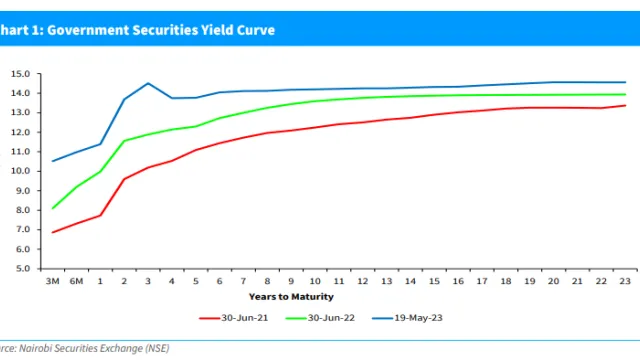Is CBK yield curve inverting signaling recession?

Is CBK yield curve inverting signaling recession?
Short term bonds and bill rates are slowly rising above longer dated government papers setting the stage for what is called an inverted yield curve that is traditionally used to signal oncoming recession.
Pressure to repay local loans have pushed short-term interest rates above 11 percent on the three, six and one-year Treasury Bills even as three short-term bonds costs rose above 14 percent.
An inverted yield curve occurs when yields on shorter-dated Treasuries rise above those for longer-term ones suggesting that while investors expect interest rates to rise in the near term, they believe that higher borrowing costs will eventually hurt the economy.

Analysts say Kenya’s yield curve is currently more of a flat one than inverted but add that the short end is rising fast because the yield on the long end was suppressed posing the risk of moving into a slowing economy amid sustained high prices.
Churchill Ogutu Economist at IC Group says Treasury Bills are now just 200 basis points off average lending rates in the market, which means banks would rather give government money for three months for 11 percent than to businesses for several years at 12 to 13 percent, a move that could constrain private sector credit and drive towards economic slowdown.
Read also: World Bank extra billions to cover funding shortfall from failed Eurobond
"Also the upward shift in T-Bills is penciling in near-term fiscal concerns leading investors to reduce their duration. Similar play occured in the US recently with its short-tenor T-Bills rates which shot up in the run up before a debt ceiling deal was firmed up," Mr Ogutu said.
The bond market is a great predictor of inflation and the direction of the economy.
Kenyan investors are not showing confidence on the longterm prospects of the economy or government’s ability to meet maturing bonds pilling money on three months paper while ignoring six and one year Treasury bills.
The government agreed to pay 11.10 on Kes17.5 billion for three months after it faced redemptions of up to Kes13.5 billion.
The government had advertised for only Kes4 billion for the 91-day paper, but received bids of over Kes20 billion out of which Treasury accepted Kes17.5 billion.
The pressure to repay short-term debt forced the government’s hand, which now priced the three-month paper at the same rate as the six month (11.1 percent) and one year (11.4 percent) automatically making those instruments unattractive.
The Government sought Kes10 billion for six months and only got Kes549 million and another Kes10 billion for a year and only got Kes2.5 billion. They took everything on the table.
The Central Bank of Kenya (CBK) has offered three, 3-year bonds, mostly tap sales, as it seeks to reap from sustained investor interest without aggressively shifting the yield curve resulting in an average 14 percent return signaling consensus on pricing and market concentration on the short-term in the current high interest rate environment.
After the three successful short-term bond offers, the CBK has recently tested the market with a seven-year infrastructure bond that comes tax free with amortized settlements that is likely to attract very positive subscription but will test the government’s willingness to pay more for local debt.
Since CBK raised Central Bank Rate by 75 basis points to 9.5 percent in March, longer dated bonds issued have performed dismally as lenders stayed away, demanding a higher return on government paper, consequently disrupting Treasury plans for lengthening maturities at lower costs.
Higher interest rates are expected to filter into the market with banks raising the cost of consumer loans, driving up defaults and cost of doing business which will negatively impact the economy.
Data by Metropol CRB shows that the number of mobile loans accounts that were in arrears for over 90 days jumped to 19.97 million from 16 million a year earlier and 18.9 million in 2020.
The increase is in line with the rise in NPL levels that rose to 14 percent of gross loans in February up from 13. 3 percent in December last year indicating a deteriorating credit performance.



